
Featured Topic: Valentine Math Activities
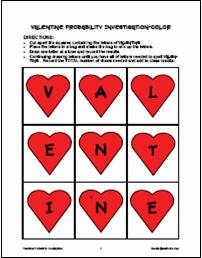
PROBABILITY: These Valentine's Day activities are based on the small candy hearts popular around this holiday. Instead of sayings, these mathematical hearts have letters. Students are trying to accumulate all of the letters in the word VALENTINE or HEART. They first predict how many letters they will have to draw from the bag, then they conduct the experiment, collect and organize data and analyze the class results.
- Download
 Valentine Probability for a straightforward probability handout.
Valentine Probability for a straightforward probability handout.
- Download
 Valentine Probability Investigation for the hearts and recording sheet to conduct the probability investigation on how many letters students will have to draw (with replacement) to get all of the letters in the word VALENTINE.
Valentine Probability Investigation for the hearts and recording sheet to conduct the probability investigation on how many letters students will have to draw (with replacement) to get all of the letters in the word VALENTINE.
- Download
 Heart Probability Investigation for the hearts and recording sheet to conduct the simplified probability investigation on how many letters students will have to draw (with replacement) to get all of the letters in the word HEART.
Heart Probability Investigation for the hearts and recording sheet to conduct the simplified probability investigation on how many letters students will have to draw (with replacement) to get all of the letters in the word HEART.

DISCRETE MATH: These activities develop students' awareness of discrete math topics: Pascal's Triangle, pathways, and combinations.
- Download
 How Many Ways Can You Spell HEART ? Teachers should make a transparency of the first page to use in explaining the task. Insert the transparency in a sheet protector so that you can use dry-erase markers and easily erase to show the different paths. Each student needs a copy of the second page. They should show one path in each box until they have found all 16 possible paths. Encourage students to use a systematic process so that they find every possible path. The accompanying answer sheet demonstrates a systematic approach that is effective in solving these types of problems.
How Many Ways Can You Spell HEART ? Teachers should make a transparency of the first page to use in explaining the task. Insert the transparency in a sheet protector so that you can use dry-erase markers and easily erase to show the different paths. Each student needs a copy of the second page. They should show one path in each box until they have found all 16 possible paths. Encourage students to use a systematic process so that they find every possible path. The accompanying answer sheet demonstrates a systematic approach that is effective in solving these types of problems.
-
 Valentine's Day Treat challenges students to list all of the possible sundaes that can be made if students choose one ice cream and one topping from the cafeteria list. Note that students must choose a topping for this problem, otherwise they are simply buying ice cream which doesn't count as a sundae.
Valentine's Day Treat challenges students to list all of the possible sundaes that can be made if students choose one ice cream and one topping from the cafeteria list. Note that students must choose a topping for this problem, otherwise they are simply buying ice cream which doesn't count as a sundae.
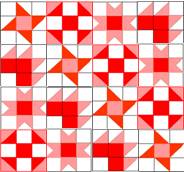
Valentine Quilts
This Valentine Quilt is a great culminating activity for a study of the geometry of quilts. Each student designs a 9-square paper quilt patch using only red, pink and white paper. Students may elect to use a traditional quilt pattern or design their own original pattern and name it. Assemble all of the quilt squares into a class quilt.
- See
 Quilt Menu for resources for teaching a mathematical quilting unit.
Quilt Menu for resources for teaching a mathematical quilting unit.
Valentine Symmetric Faces
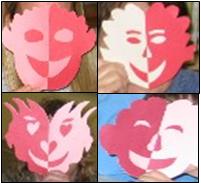
Reinforce the concept of symmetry with this art project which colored paper and symmetrical placement to create symmetric masks. Use red, pink and white paper for Valentine's day or red, white and blue paper for patriotic masks for President's Day.
- See
 Symmetric Faces for instructions on creating these masks from 1.5 sheets of construction paper. Students will develop an "eye" for symmetry as they correctly place cut pieces to create a symmetric face.
Symmetric Faces for instructions on creating these masks from 1.5 sheets of construction paper. Students will develop an "eye" for symmetry as they correctly place cut pieces to create a symmetric face.
- See
 Symmetric Faces Photo Gallery for ideas to get the creative juices flowing. Note how the color combinations as well as the facial features affect the final product.
Symmetric Faces Photo Gallery for ideas to get the creative juices flowing. Note how the color combinations as well as the facial features affect the final product.
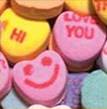
Mathwire Valentine's Day Math Activities Collection
See more  Valentine's Day Math Activities from the Mathwire collection that include suggestions for math activities that use the small candy valentine hearts to practice graphing, fractions, counting and patterns. Students might also use the candy to play the Grab the Candy!game. The collection includes more problem solving and discrete math activities as well as a suggestion to make Valentine Symmetric Faces to study symmetry.
Valentine's Day Math Activities from the Mathwire collection that include suggestions for math activities that use the small candy valentine hearts to practice graphing, fractions, counting and patterns. Students might also use the candy to play the Grab the Candy!game. The collection includes more problem solving and discrete math activities as well as a suggestion to make Valentine Symmetric Faces to study symmetry.
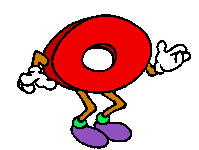

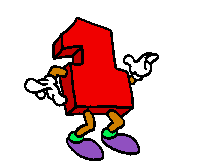
100th Day of School Activities
Numbers: ARG Animation
As you start to plan for the Hundredth Day of School, be sure to check out the Mathwire collections for this special day. The collections include activities, handouts, games, links, problem solving and literature connections.
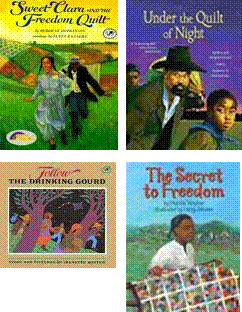
Freedom Quilts
There is much written about the use of quilts during the Underground Railroad days. Known as the Freedom Quilt patterns, these quilts were displayed as signals to slaves that they should begin to pack for the journey (Wagon Wheel),dress up (Shoofly) and get ready to escape (Tumbling Blocks). Quilts were also used to alert fugitive slaves to food (Bear's Paw), the way north (Star) and danger (Log Cabin). Because quilts were such an American tradition, they could be hung on porches or displayed on fences without attracting attention.
Freedom quilts and the history of their use by the Underground Railroad as a secret code for fugitive slaves relates geometry, literature and history, providing an interdisciplinary approach to this important topic.
- See
 Freedom Quilts.
Freedom Quilts.
- Visit the
 Mathematical Quilts Menu to see all quilting activities.
Mathematical Quilts Menu to see all quilting activities.

Recent Additions to Mathwire.com
Check the  New on Mathwire.com webpage to see what's new on the site this month.
New on Mathwire.com webpage to see what's new on the site this month.
Check the  Recent Additions to Mathwire.com webpage to see the most recent additions to the site this month.
Recent Additions to Mathwire.com webpage to see the most recent additions to the site this month.
Enter your email address below to receive notifications when new content is added to Mathwire.
NOTICE: If you have already subscribed to the Mathwire.com Updates but have not been receiving any notices, this may be due to your school's e-mail system that does not allow these mailings to be delivered. Please feel free to resubscribe using a different e-mail account rather than your school account.
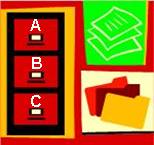
Mathwire Search Options
New to Mathwire.com? There are several ways to search the site for activities by Math Standard, Math Topic, or using an alphabetical (A-Z List) search.
- See
 Searching the Mathwire.com Site for a thorough explanation of these search options.
Searching the Mathwire.com Site for a thorough explanation of these search options.
About Mathwire.com
Mathwire.com is designed to provide activities and appropriate worksheets for teachers to use in their classrooms. All activities and worksheets support the constructivist approach to learning mathematics and the NCTM Standards.
Activities: The activities on this site were developed by Terry Kawas and the teachers in districts where she has worked as a math consultant and coach or with students she has taught in college math-methods courses. The activities are classroom-tested by teachers and appropriate modifications have been made to reflect this field-testing. These activities are posted online in an effort to share quality activities and routines within the mathematics community.
Terms of Use: Teachers are welcome to download any of the activities for free use in their classrooms. No activities may be copied for use on other websites or included in commercial products without permission in writing from Terry Kawas, webmaster. Contact Terry Kawas
